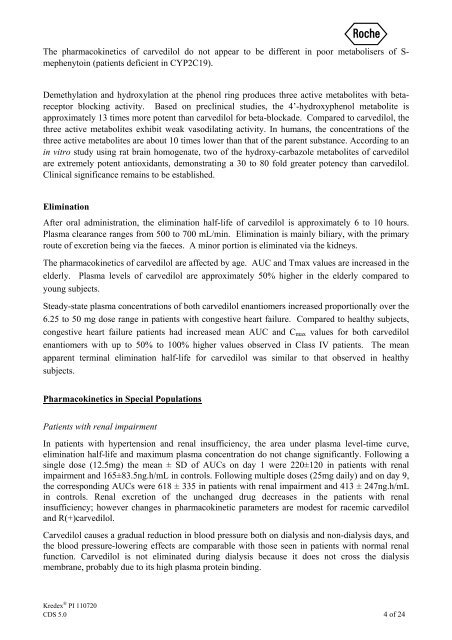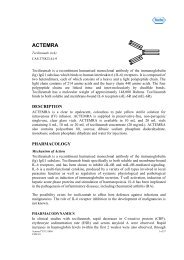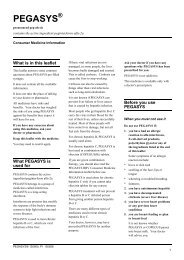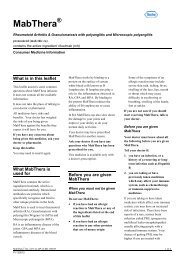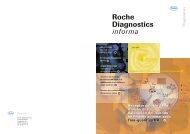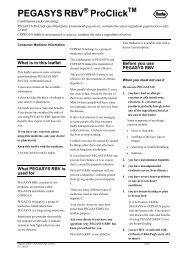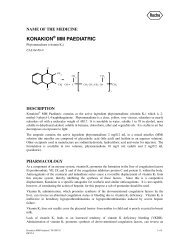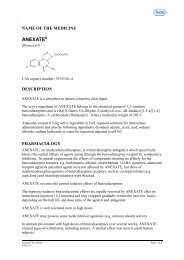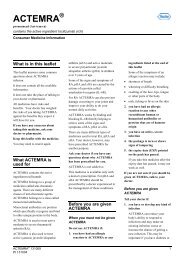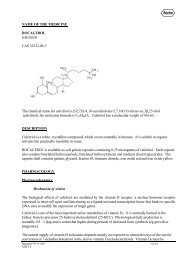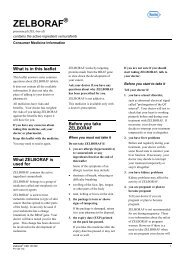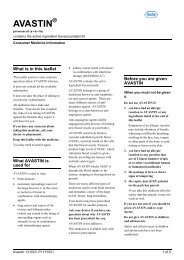Kredex (carvedilol) - Product Information (PI) - Roche Australia
Kredex (carvedilol) - Product Information (PI) - Roche Australia
Kredex (carvedilol) - Product Information (PI) - Roche Australia
Create successful ePaper yourself
Turn your PDF publications into a flip-book with our unique Google optimized e-Paper software.
The pharmacokinetics of <strong>carvedilol</strong> do not appear to be different in poor metabolisers of S-<br />
mephenytoin (patients deficient in CYP2C19).<br />
Demethylation and hydroxylation at the phenol ring produces three active metabolites with betareceptor<br />
blocking activity. Based on preclinical studies, the 4’-hydroxyphenol metabolite is<br />
approximately 13 times more potent than <strong>carvedilol</strong> for beta-blockade. Compared to <strong>carvedilol</strong>, the<br />
three active metabolites exhibit weak vasodilating activity. In humans, the concentrations of the<br />
three active metabolites are about 10 times lower than that of the parent substance. According to an<br />
in vitro study using rat brain homogenate, two of the hydroxy-carbazole metabolites of <strong>carvedilol</strong><br />
are extremely potent antioxidants, demonstrating a 30 to 80 fold greater potency than <strong>carvedilol</strong>.<br />
Clinical significance remains to be established.<br />
Elimination<br />
After oral administration, the elimination half-life of <strong>carvedilol</strong> is approximately 6 to 10 hours.<br />
Plasma clearance ranges from 500 to 700 mL/min. Elimination is mainly biliary, with the primary<br />
route of excretion being via the faeces. A minor portion is eliminated via the kidneys.<br />
The pharmacokinetics of <strong>carvedilol</strong> are affected by age. AUC and Tmax values are increased in the<br />
elderly. Plasma levels of <strong>carvedilol</strong> are approximately 50% higher in the elderly compared to<br />
young subjects.<br />
Steady-state plasma concentrations of both <strong>carvedilol</strong> enantiomers increased proportionally over the<br />
6.25 to 50 mg dose range in patients with congestive heart failure. Compared to healthy subjects,<br />
congestive heart failure patients had increased mean AUC and C max values for both <strong>carvedilol</strong><br />
enantiomers with up to 50% to 100% higher values observed in Class IV patients. The mean<br />
apparent terminal elimination half-life for <strong>carvedilol</strong> was similar to that observed in healthy<br />
subjects.<br />
Pharmacokinetics in Special Populations<br />
Patients with renal impairment<br />
In patients with hypertension and renal insufficiency, the area under plasma level-time curve,<br />
elimination half-life and maximum plasma concentration do not change significantly. Following a<br />
single dose (12.5mg) the mean ± SD of AUCs on day 1 were 220±120 in patients with renal<br />
impairment and 165±83.5ng.h/mL in controls. Following multiple doses (25mg daily) and on day 9,<br />
the corresponding AUCs were 618 ± 335 in patients with renal impairment and 413 ± 247ng.h/mL<br />
in controls. Renal excretion of the unchanged drug decreases in the patients with renal<br />
insufficiency; however changes in pharmacokinetic parameters are modest for racemic <strong>carvedilol</strong><br />
and R(+)<strong>carvedilol</strong>.<br />
Carvedilol causes a gradual reduction in blood pressure both on dialysis and non-dialysis days, and<br />
the blood pressure-lowering effects are comparable with those seen in patients with normal renal<br />
function. Carvedilol is not eliminated during dialysis because it does not cross the dialysis<br />
membrane, probably due to its high plasma protein binding.<br />
<strong>Kredex</strong> ® <strong>PI</strong> 110720<br />
CDS 5.0 4 of 24


